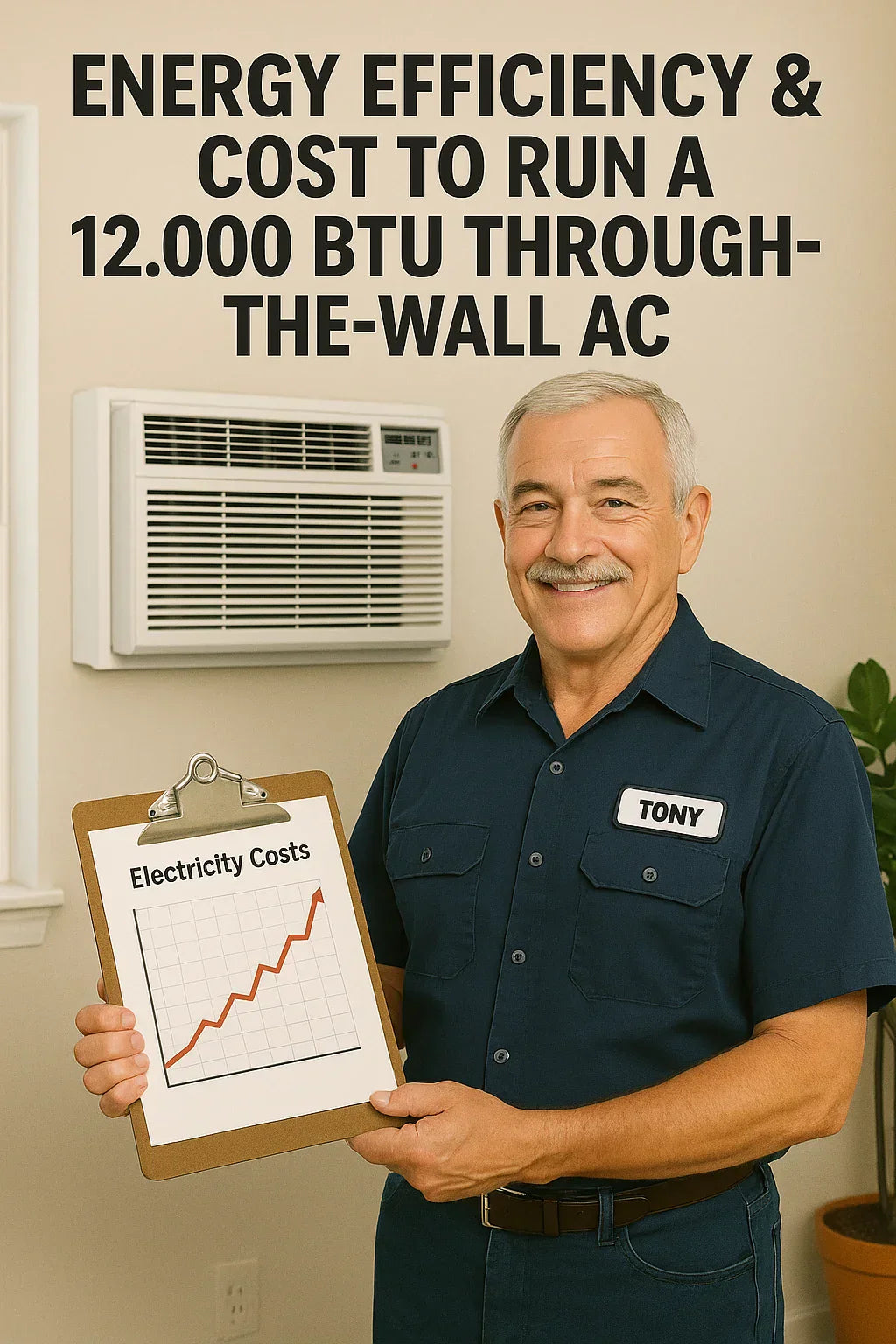🧊 Introduction: Why This Matters Before You Buy
Before you invest in a GE 12,000 BTU Through-the-Wall AC with Electric Heat, understanding energy efficiency and operating costs will help you:
-
Plan your monthly utility budget
-
Choose a unit with the right CEER (Combined Energy Efficiency Ratio)
-
Maximize comfort while minimizing waste
-
Decide on upgrades like programmable thermostats or smart plugs
Tony says:
“A unit that’s cheap upfront but inefficient will cost you more over time. Let’s break down the numbers.”
🔎 Understanding BTUs and Power Consumption
-
12,000 BTUs = ~1 ton of cooling capacity, suitable for ~450-550 sq ft.
-
Power draw ranges between 900–1,500 watts per hour depending on:
-
Indoor and outdoor temperature
-
Fan speed
-
Heat mode operation
-
-
Electric heat mode can draw 3,000–4,000 watts per hour during operation.
Reference: DOE Room Air Conditioners Guide
⚡ What Is CEER and Why It Matters
CEER (Combined Energy Efficiency Ratio) measures how efficiently your AC uses energy while accounting for standby/off-mode power consumption.
-
A higher CEER = lower electricity consumption.
-
Modern efficient units have CEER ratings of 10–12+.
-
Example: A unit with a CEER of 11 uses less energy for the same cooling output than a unit with a CEER of 9.
Reference: Energy Star Room AC Efficiency
💰 Calculating Cost to Run Your 12,000 BTU AC
Formula:
Watts ÷ 1000 x Cost per kWh x Hours of use per day = Daily Cost
Example:
-
Unit draws 1,200 watts in cooling mode.
-
Local electricity cost = $0.15 per kWh.
-
Operating 8 hours per day during peak summer.
Calculation: 1,200 ÷ 1000 = 1.2 kW 1.2 kW x $0.15 = $0.18 per hour $0.18 x 8 = $1.44 per day Monthly (30 days) = $43.20
Electric heat mode costs will be 2–3x higher per hour, so consider using it for supplemental heating only.
Reference: Energy Cost Calculator
🛠️ Tips to Reduce Operating Costs
✅ Use a programmable thermostat to reduce unnecessary run times. ✅ Clean filters regularly for airflow efficiency. ✅ Seal around your unit and wall sleeve to prevent air leaks. ✅ Use ceiling fans to circulate cool air, allowing higher thermostat settings. ✅ Close blinds and curtains to reduce heat gain during peak sun hours. ✅ Upgrade to an Energy Star certified unit if replacing an older AC.
🌡️ Impact of Local Climate and Room Conditions
Operating costs can vary by:
-
Climate: Hotter regions increase runtime.
-
Insulation: Poor insulation forces longer operation.
-
Sunlight exposure: West-facing rooms can heat up significantly.
-
Occupants and electronics: More people and devices = more heat load.
Consider these when estimating your true operational costs.
🔋 How Electric Heat Mode Impacts Your Bills
The electric heat mode in through-the-wall AC units is typically resistance heating, which:
-
Consumes significantly more electricity per hour.
-
Is useful for spot heating small spaces.
-
Is less efficient than heat pumps or gas heating.
Tony’s Tip:
“Use electric heat for those chilly mornings or a cold snap, but don’t rely on it as your main heating source if you’re trying to save on bills.”
Reference: DOE Home Heating Basics
🧮 Comparing Different CEER Ratings on Cost
| CEER Rating | kWh per Hour | Cost per Hour ($0.15/kWh) |
|---|---|---|
| 9 | 1.33 | $0.20 |
| 10 | 1.20 | $0.18 |
| 11 | 1.09 | $0.16 |
| 12 | 1.00 | $0.15 |
Over a summer of 90 days, 8 hours/day, the difference between CEER 9 vs. CEER 12 can save $45–$50 in energy costs.
💡 When to Consider an Upgrade
If your current AC: ✅ Is more than 10 years old ✅ Has a CEER below 9 ✅ Requires frequent repairs ✅ Uses R-22 refrigerant
…it may be more cost-effective to replace it with a modern, efficient 12,000 BTU through-the-wall unit.
Reference: Energy Star AC Replacement Guide
✅ Conclusion: Key Takeaways
-
A 12,000 BTU through-the-wall AC typically costs $35–$55/month to run during heavy summer use.
-
Electric heat mode should be used sparingly due to higher costs.
-
Look for units with CEER 10+ to maximize efficiency.
-
Using maintenance and energy-saving practices will reduce your costs further.
Tony’s Final Reminder:
“Buy smart, maintain it regularly, and you’ll keep cool without burning a hole in your wallet.”
In the next topic we will know more about: How to Maintain Your GE 12,000 BTU Through-the-Wall AC for Long-Term Performance







